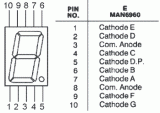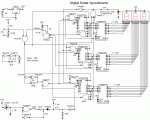Description:
The circuit of Fig.1 provides an easy yet reliable way to detect the intensity of a.c. (or e.l.f.) fields around the home or workplace. It is doubly effective because it does not merely detect the electromagnetic radiation emitted by electrical appliances, but the electromagnetic energy actually absorbed by the body.
The circuit in Fig.1 is a standard charge pump which is charged by the alternating eddy currents induced in the human body by a.c. fields. C1 charges virtually instantly, and is read by a digital (or high impedance) voltmeter.
To obtain a very rough translation from millivolts to milligauss (the unit of magnetic field strength), divide the millivolts reading by four. For example, 1000mV will yield 250 milligauss. A rough guide to the readings follows:
Up to 3 milligauss - Low electromagnetic radiation
25 milligauss - Significant electromagnetic radiation
100 milligauss - High electromagnetic radiation
250 milligauss - Maximum risk exposure
Detrimental effects have been reported at doses as low as 3 milligauss, and a series of studies since the 1970's has shown that sustained exposure to high e.l.f. doses heightens the risk of certain cancers and miscarriage.
Readings are taken while holding the probe in one hand. The closest proximity to the electromagnetic source does not necessarily give the highest reading, probably because the induced currents in the body remain localised at close proximity.
The Sensor
Is any piece of metal (e.g. a short stub of copper piping, even a short piece of fencing wire) that makes good contact with the hand.
Author: Rev. Thomas Scarborough
Email: scarboro@iafrica.com
Website: http://www.zen22142.zen.co.uk

 Audio
Audio







